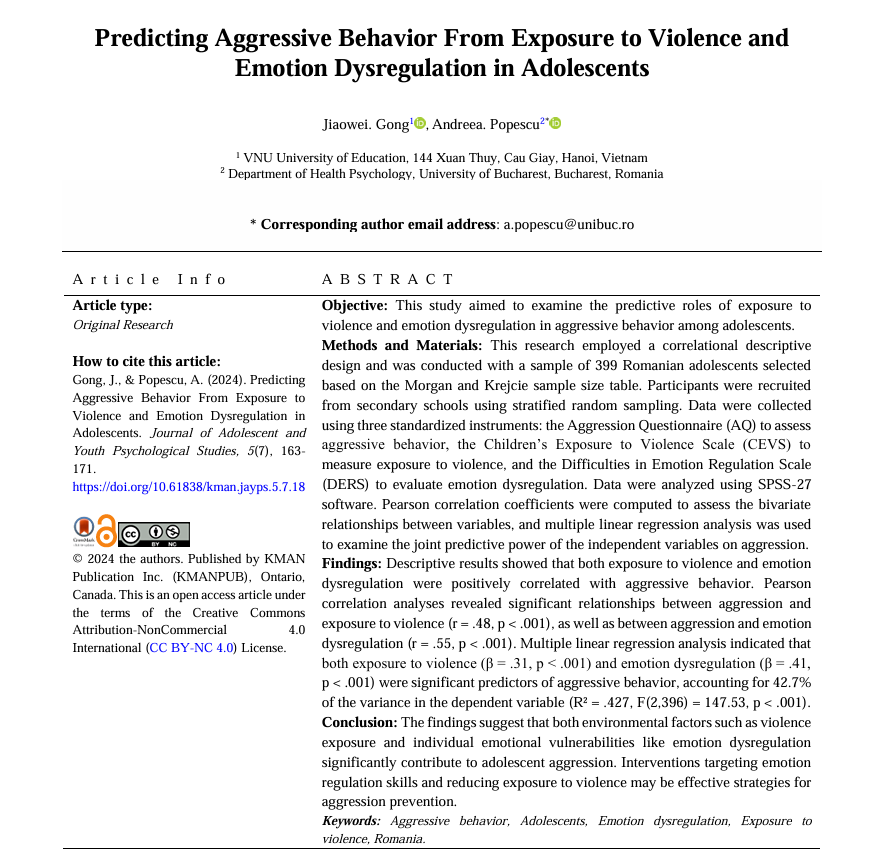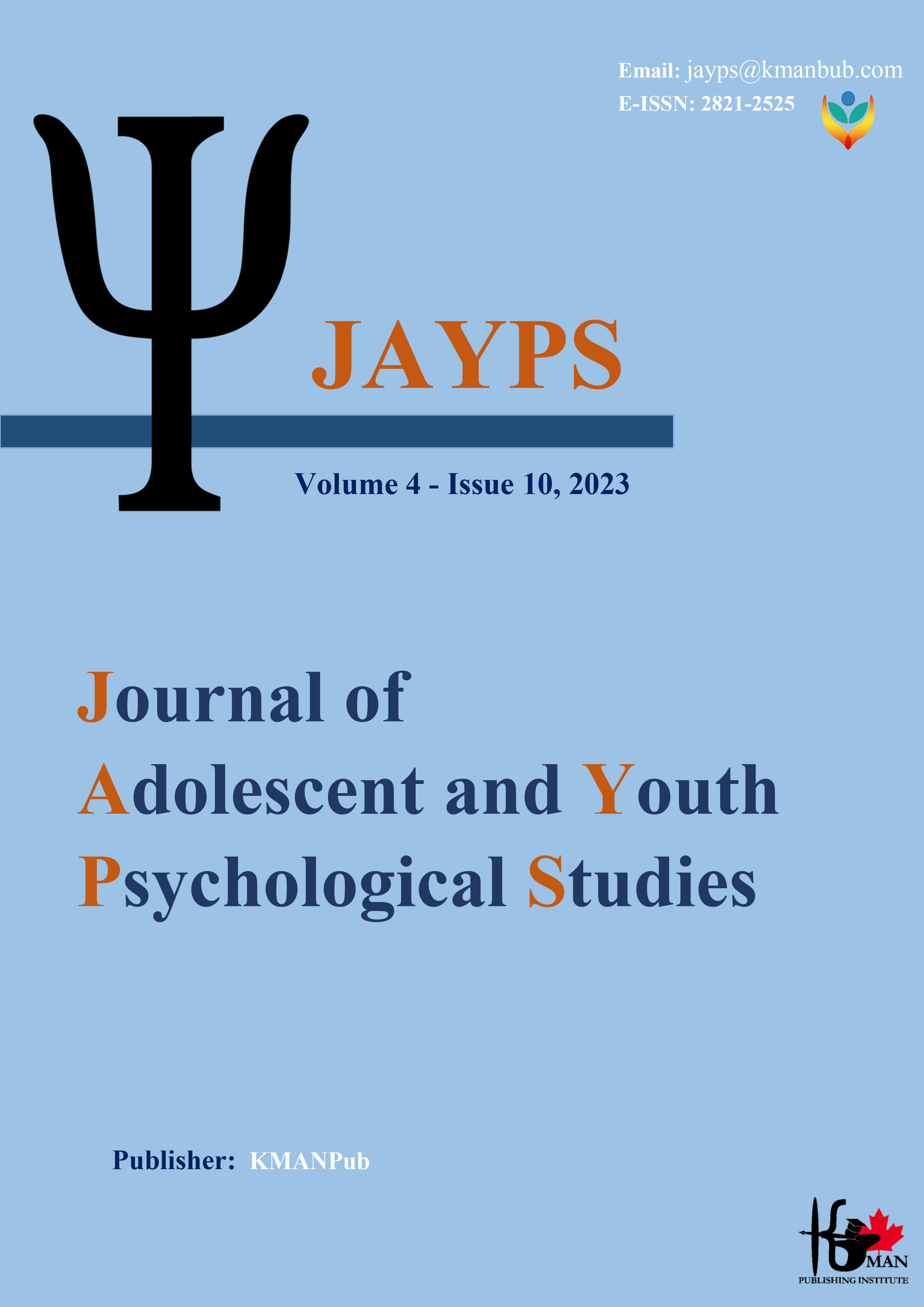Predicting Aggressive Behavior From Exposure to Violence and Emotion Dysregulation in Adolescents
Keywords:
Aggressive behavior, Adolescents, Emotion dysregulation, Exposure to violence, RomaniaAbstract
Objective: This study aimed to examine the predictive roles of exposure to violence and emotion dysregulation in aggressive behavior among adolescents.
Methods and Materials: This research employed a correlational descriptive design and was conducted with a sample of 399 Romanian adolescents selected based on the Morgan and Krejcie sample size table. Participants were recruited from secondary schools using stratified random sampling. Data were collected using three standardized instruments: the Aggression Questionnaire (AQ) to assess aggressive behavior, the Children’s Exposure to Violence Scale (CEVS) to measure exposure to violence, and the Difficulties in Emotion Regulation Scale (DERS) to evaluate emotion dysregulation. Data were analyzed using SPSS-27 software. Pearson correlation coefficients were computed to assess the bivariate relationships between variables, and multiple linear regression analysis was used to examine the joint predictive power of the independent variables on aggression.
Findings: Descriptive results showed that both exposure to violence and emotion dysregulation were positively correlated with aggressive behavior. Pearson correlation analyses revealed significant relationships between aggression and exposure to violence (r = .48, p < .001), as well as between aggression and emotion dysregulation (r = .55, p < .001). Multiple linear regression analysis indicated that both exposure to violence (β = .31, p < .001) and emotion dysregulation (β = .41, p < .001) were significant predictors of aggressive behavior, accounting for 42.7% of the variance in the dependent variable (R² = .427, F(2,396) = 147.53, p < .001).
Conclusion: The findings suggest that both environmental factors such as violence exposure and individual emotional vulnerabilities like emotion dysregulation significantly contribute to adolescent aggression. Interventions targeting emotion regulation skills and reducing exposure to violence may be effective strategies for aggression prevention.
Downloads
References
Bell, K. M., Howard, L., & Cornelius, T. L. (2020). Emotion Dysregulation as a Moderator of the Association Between Relationship Dependency and Female-Perpetrated Dating Aggression. Journal of interpersonal violence, 37(5-6), NP2891-NP2911. https://doi.org/10.1177/0886260520945678
Bounoua, N., Spielberg, J. M., & Sadeh, N. (2022). Clarifying the Synergistic Effects of Emotion Dysregulation and Inhibitory Control on Physical Aggression. Human Brain Mapping, 43(17), 5358-5369. https://doi.org/10.1002/hbm.26012
Bresin, K., Mekawi, Y., Stevens, J. S., Hinrichs, R., Fani, N., Michopoulos, V., & Powers, A. (2021). From Alcohol to Aggression: Examining the Structure and Nomological Network of Dysregulated Behaviors in a Trauma‐exposed Community Sample. Journal of Clinical Psychology, 78(6), 1220-1239. https://doi.org/10.1002/jclp.23288
Çelebi, Ş., & Acar, İ. H. (2024). Investigating Correlates of Children's Emotional Well‐being: Parenting Stress and Child Temperament. Infant and Child Development, 33(6). https://doi.org/10.1002/icd.2539
Cenk, S. C. (2019). An analysis of the exposure to violence and burnout levels of ambulance staff. Turkish Journal of Emergency Medicine, 19(1), 21-25. https://doi.org/10.1016/j.tjem.2018.09.002
Clear, S. J., Gardner, A. A., Webb, H. J., & Zimmer‐Gembeck, M. J. (2019). Common and Distinct Correlates of Depression, Anxiety, and Aggression: Attachment and Emotion Regulation of Sadness and Anger. Journal of Adult Development, 27(3), 181-191. https://doi.org/10.1007/s10804-019-09333-0
Darmadi, I. R., & Badayai, A. R. A. (2021). The Relationship Between Emotional Dysregulation and Aggressive Behavior Among Adolescents. International Journal of Academic Research in Business and Social Sciences, 11(6). https://doi.org/10.6007/ijarbss/v11-i6/10238
Espírito‐Santo, H., Daniel, F., Lemos, L., Simões, L., & Grasina, A. (2022). Alexithymia and Aggressiveness in Old Age: Mediation by Impulsivity and Emotion Dysregulation. Psychology Society & Education, 14(1), 35-43. https://doi.org/10.21071/psye.v14i1.14180
Ford, J. D. (2021). Emotional Dysregulation and Adaptive Self-Regulation. 33-62. https://doi.org/10.1037/0000225-003
Garofalo, C., Neumann, C. S., & Velotti, P. (2020). Psychopathy and Aggression: The Role of Emotion Dysregulation. Journal of interpersonal violence, 36(23-24), NP12640-NP12664. https://doi.org/10.1177/0886260519900946
Garofalo, C., & Velotti, P. (2017). Negative Emotionality and Aggression in Violent Offenders: The Moderating Role of Emotion Dysregulation. Journal of Criminal Justice, 51, 9-16. https://doi.org/10.1016/j.jcrimjus.2017.05.015
Garofalo, C., Velotti, P., & Zavattini, G. C. (2018). Emotion Regulation and Aggression: The Incremental Contribution of Alexithymia, Impulsivity, and Emotion Dysregulation Facets. Psychology of violence, 8(4), 470-483. https://doi.org/10.1037/vio0000141
Harmsel, J. F. t., Josanne, D. M. v. D., Zijlmans, J., Thimo, M. v. d. P., Marhe, R., & Popma, A. (2022). Neurobiological Responses Towards Stimuli Depicting Aggressive Interactions in Delinquent Young Adults and Controls: No Relation to Reactive and Proactive Aggression. Brain Sciences, 12(2), 124. https://doi.org/10.3390/brainsci12020124
Hatfield, O., Bresin, K., Mekawi, Y., Michopoulos, V., Fani, N., Bradley, B., & Powers, A. (2024). Predicting Aggressive Behaviors: Examining Unique and Interactive Roles of PTSD and Emotion Dysregulation in a Minority Sample. Aggressive Behavior, 50(3). https://doi.org/10.1002/ab.22149
Heinze, J. E., Stoddard, S. A., Aiyer, S. M., Eisman, A. B., & Zimmerman, M. A. (2017). Exposure to violence during adolescence as a predictor of perceived stress trajectories in emerging adulthood. Journal of Applied Developmental Psychology, 49, 31-38. https://doi.org/10.1016/j.appdev.2017.01.005
Jakobi, B., Väsquez, A. A., Hermans, E. J., Vlaming, P., Buitelaar, J. K., Franke, B., Hoogman, M., & Rooij, D. v. (2022). Neural Correlates of Reactive Aggression in Adult Attention-Deficit/Hyperactivity Disorder. Frontiers in Psychiatry, 13. https://doi.org/10.3389/fpsyt.2022.840095
Kun, B., Szabó, A., Mägi, A., Eisinger, A., & Demetrovics, Z. (2022). Emotion Dysregulation Mediates the Relationship Between Psychological Distress, Symptoms of Exercise Addiction and Eating Disorders: A Large-Scale Survey Among Fitness Center Users. Sport Exercise and Performance Psychology, 11(2), 198-213. https://doi.org/10.1037/spy0000274
LaBrenz, C. A., Dell, P. J., Fong, R., & Liu, V. (2019). Happily Ever After? Life Satisfaction After Childhood Exposure to Violence. Journal of interpersonal violence, 36(13-14), NP6747-NP6766. https://doi.org/10.1177/0886260518820706
Meaney, R., Hasking, P., & Reupert, A. (2016). Borderline Personality Disorder Symptoms in College Students: The Complex Interplay Between Alexithymia, Emotional Dysregulation and Rumination. PLoS One, 11(6), e0157294. https://doi.org/10.1371/journal.pone.0157294
Miles, S. R., Menefee, D. S., Wanner, J. L., Tharp, A. T., & Kent, T. A. (2015). The Relationship Between Emotion Dysregulation and Impulsive Aggression in Veterans With Posttraumatic Stress Disorder Symptoms. Journal of interpersonal violence, 31(10), 1795-1816. https://doi.org/10.1177/0886260515570746
Northrup, J. B., Goodwin, M. S., Peura, C., Chen, Q., Taylor, B. J., Siegel, M., & Mazefsky, C. A. (2022). Mapping the Time Course of Overt Emotion Dysregulation, Self‐injurious Behavior, and Aggression in Psychiatrically Hospitalized Autistic Youth: A Naturalistic Study. Autism Research, 15(10), 1855-1867. https://doi.org/10.1002/aur.2773
Oberle, E., McLachlan, K., Catherine, N., Brain, U., Schonert‐Reichl, K. A., Weinberg, J., & Oberlander, T. F. (2017). Afternoon Cortisol Provides a Link Between Self‐regulated Anger and Peer‐reported Aggression in Typically Developing Children in the School Context. Developmental Psychobiology, 59(6), 688-695. https://doi.org/10.1002/dev.21522
Perry, T. R. (2023). The Role of Emotion Dysregulation in Problematic Exercise in Those With Eating Disorders. Journal of Emotion and Psychopathology, 1(1), 302-312. https://doi.org/10.55913/joep.v1i1.24
Rademacher, A., Zumbach, J., & Koglin, U. (2023). Parenting Style and Child Aggressive Behavior From Preschool to Elementary School: The Mediating Effect of Emotion Dysregulation. Early Childhood Education Journal, 53(1), 63-72. https://doi.org/10.1007/s10643-023-01560-1
Sevecke, K., Franke, S., Kosson, D. S., & Krischer, M. (2016). Emotional Dysregulation and Trauma Predicting Psychopathy Dimensions in Female and Male Juvenile Offenders. Child and adolescent psychiatry and mental health, 10(1). https://doi.org/10.1186/s13034-016-0130-7
Simonič, B., Poljak Lukek, S., Valenta, T., Jerebic, D., Jerebic, S., Rijavec Klobučar, N., & Pate, T. (2024). The Role of Emotion Dysregulation in Problematic Alcohol Use and Coping with Problems. European Journal of Mental Health, 19, 1-15. https://doi.org/10.5708/EJMH.19.2024.0018
Stefanile, C., Matera, C., Nerini, A., Puddu, L., & Raffagnino, R. (2017). Psychological Predictors of Aggressive Behavior Among Men and Women. Journal of interpersonal violence, 36(1-2), NP920-NP941. https://doi.org/10.1177/0886260517737553
Toro, R., Basurto, F. Z., Armenta, M. F., & García, J. G. (2024). Behavioral Inhibition and Activation Systems, Negative Affect, Dysregulation and Anger Rumination as Explanatory Variables of Aggressive and Antisocial Behaviors. https://doi.org/10.20944/preprints202411.2033.v1
Velotti, P., Casselman, R. B., Garofalo, C., & McKenzie, M. D. (2017). Unique Associations Among Emotion Dysregulation Dimensions and Aggressive Tendencies: A Multisite Study. Violence and Victims, 32(5), 791-810. https://doi.org/10.1891/0886-6708.vv-d-16-00079
Zhang, J., Li, Y., Li, J., Lyu, M., Chen, Y., Yang, S., Tan, C., Tao, Y., Ye, B., Zhang, J., Cheng, F., & Mao, T. (2023). The effect of life events, resilience, self-esteem, and coping styles on aggressive behavior among left-behind adolescents: Structural equation modeling [Original Research]. Frontiers in Psychiatry, 14. https://doi.org/10.3389/fpsyt.2023.991608

Downloads
Additional Files
Published
Submitted
Revised
Accepted
Issue
Section
License

This work is licensed under a Creative Commons Attribution-NonCommercial 4.0 International License.








